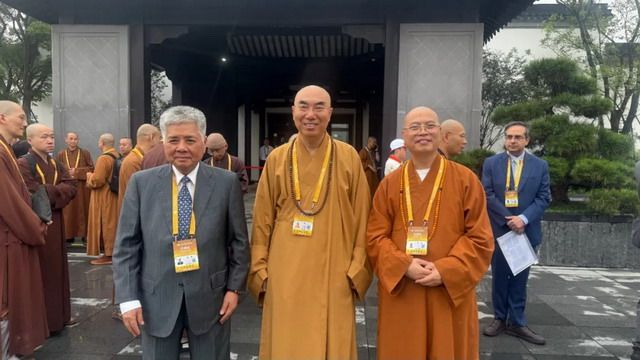达义大和尚在第六届世界佛教论坛论文中金句精选
世界佛教论坛已经成为团结和联系全世界佛教徒的一面旗帜。
The World Buddhist Forum has become a banner for uniting and connecting Buddhists around the world.
加拿大佛教会与世界佛教论坛始终“同愿同行”。十八年前,我在首届世界佛教论坛上,向全世界宣布:在北美大地兴建加国佛教四大名山,首期工程为加国五台山。今年四月,加国五台山对外正式开放。
The Buddhist Association of Canada has always “shared aspirations” with the World Buddhist Forum. Eighteen years ago, at the First World Buddhist Forum, I announced to the world that the Four Great Buddhist Mountains of Canada would be built in North America, with the first phase being the Wutai Shan Buddhist Garden. This April, Canada’s Wutai Shan Buddhist Garden was officially opened to the public.

— 广告 —
— 大洋海产 加拿大的急冻海鲜先锋 —
回眸佛教公益慈善的历史,意在确认两个历史的维度:第一,佛教具有传承悠久且运行良好的公益慈善传统;第二,佛教公益慈善的形式从来都不是单纯作一些捐赠或者布施,而是本着真心帮助社会、帮助民众解决困难的初心,行一切方便法门利益众生,是一种“整体的慈善观”。
Looking back at the history of Buddhist philanthropic activities which reveals two historical dimensions: First, Buddhism has a long-standing and well-functioning tradition of philanthropy; second, Buddhist philanthropy has never been merely about making donations or almsgiving. Instead, it is based on the genuine intention of a sincere desire to help society and assist people in overcoming difficulties, practice various skillful means for the benefit of all beings. This reflects a holistic concept of charity.

纵观近现代中国大乘佛教的振兴,中国佛教以“慈悲”为根本,以“戒律”为依规,以出世之心做入世之事,佛教公益慈善事业重新回到了济世度人的主干道上。
Looking at the revitalization of Chinese Mahayana Buddhism in modern times, Chinese Buddhism is fundamentally rooted in “compassion,” guided by “precepts,” and engaged in worldly affairs with a transcendent mindset. Buddhist philanthropy has thus returned to the main path of helping the world and saving the people to relieve suffering and benefit others.

慈悲是佛教的宗旨,公益慈善是佛教徒的天职。
Compassion is the purpose of Buddhism, public welfare and charity are the duties of Buddhists.

如果没有众生,一切菩萨终不能成无上正觉,公益慈善事业正是以大悲水饶益一切众生。
Without sentient beings, no bodhisattva can attain supreme enlightenment. Buddhist philanthropy and charitable endeavors are precisely ways to benefit all sentient beings with great compassion.

— 广告 —
— 冰酒之王,柳泉酒庄 —
布施是“六度”之首,是由凡入圣、到达涅槃彼岸的必经之路,是成佛最基础的修行方法。
Giving is the foremost of the “Six Perfections”, and is the essential path from ordinary people to saints and to the other shore of Nirvana. It is the most basic practice method for becoming a Buddha.

慈善布施不仅是单向的助他行动,更是自助的行动,通过布施行善,受施者能够得到疏困解难,施与者能获真实利益––洁净心灵、智慧显现以及未来福报的许诺,因此是一个受与施双向受益的过程。
Charitable giving is not just a one-way act of helping others, but also an act of self-help. Through the practice of giving, the recipient is relieved of difficulties, while the giver receives real benefits – a clean mind, a manifestation of wisdom, and the promise of future blessings. Thus, it is a mutually beneficial process for both the giver and the receiver.

佛法思想中最重要的内容是慈悲和智慧。智则重于上求,务求出世之法;悲则重于下化,专在人世之法。
The most important contents in Buddhist thought are compassion and wisdom. Wisdom focuses on seeking transcendence, aiming for teachings that lead one out of the world; while compassion emphasizes on helping others, concentrating on teachings that pertain to the world.

— 广告 —
— 《加国五台山》五台八景十六点!—
大乘佛教既有出世的超然,也有入世的情怀,而慈善正是实践这一修行的有效途径。
Mahayana Buddhism encompasses both transcendence from, and engagement with, the world; and charity is an effective way to practice this approach.

佛陀创教,正是要通过出世与入世的悲智双运,来救赎众生生老病死之苦……佛教慈善事业力求教养并举,使受益者深体佛陀慈悲救世、平等不二之本怀。
Buddha established the teachings to save sentient beings from the suffering of birth, aging, sickness, and death through the dual practice of transcending the world and engaging with it … Buddhist philanthropy endeavors to educate and nurture, aiming for the beneficiaries to deeply understand the Buddha’s compassion, salvation, and the principles of equality and non-duality.

受菩萨戒者,应积极办理有益大众之事,而非闭门修行。既为佛子,为国民一分子,理当为国家尽义务,为社会谋幸福,为人民觅生活。
Those who have taken the Bodhisattva precepts should actively engage in activities that benefit the public, rather than practicing behind closed doors. As a disciple of the Buddha and a member of the society, one should fulfill one’s obligation to the country, seek happiness for the community, and strive to improve the lives of the people.

— 广告 —
— 《加拿大老人幸福生活》戏剧活动,欢迎报名参加!—
大乘佛教在慈善公益历史的曲折中,完成了佛教慈善事业六个方面的积极转向。这六个方面,从理论构建,到行动指南,构成了现代大乘佛教公益慈善事业的基本格局。
In the twists and turns of the history of chariy and public welfare, Mahayana Buddhism has completed a positive turn in six aspects of the Buddhist philanthropy. These six aspects, from theoretical construction to action guidelines, constitute the basic framework of modern Mahayana Buddhism’s philanthropy.

加拿大佛教会一方面传承大乘佛教慈悲济世、利乐有情的光辉传统,一方面又要契合北美的本土化实际,进行积极的调试和探索。
The Buddhist Association of Canada not only inherits the glorious tradition of Mahayana Buddhism, which emphasizes on compassion and benefiting the sentient beings, but also actively adjusts and explores in line with the localization reality of North America.

加拿大佛教会借鉴早期大乘佛教“佛图户”的思路,将佛经翻译的成果定期寄送给北美的监狱和矫正机构,以佛法教化监狱里的受刑之人,引导他们听经闻法,改过自新。每年来自北美各地监狱索要多语种佛经的信件,纷至沓来。
The Buddhist Association of Canada draws inspiration from the early Mahayana Buddhist concept of “Buddha’s Path” by regularly sending translations of Buddhist scriptures to prisons and correctional institutions in North America. This initiative aims to educate inmates through the teachings of Buddhism, guiding them to listen to the Dharma and make positive changes in their lives. Every year, letters pour in from prisons across North America requesting multilingual Buddhist texts.

加拿大佛教会的公益慈善行动,从思想上承袭了大乘佛教济世渡人、无我利他的悲心宏愿,从行动上传承了现代佛教慈悲济世、积极入世的良好传统,从实践上结合了北美社会的慈善传统和多元文化社会的现状,以国际化视野推动佛教公益慈善事业的本土化实践。
The philanthropic activities of the Buddhist Association of Canada have inherited the Mahayana Buddhism’s ideals of helping others and selfless compassion. These efforts carry forward the positive traditions of modern engaged Buddhism, emphasizing compassion and active involvement in the world. Practically, they integrate the philanthropic traditions of North American society and the realities of a multicultural environment, promoting the localization of Buddhist philanthropic initiatives with an international perspective.

— 广告 —
— 轻松传媒活动策划 —
大乘佛教的公益慈善事业虽然在特殊的历史时期,出现了起伏甚至挫折,但佛教界的大德高僧和有识之士,顺应时代潮流力挽狂澜,引导大乘佛教重回正道,这是佛教强大的自我纠错能力的体现,是佛法弘传的强大生命力的体现。
Although the philanthropic endeavors of Mahayana Buddhism have experienced fluctuations and setbacks during certain historical periods, the virtuous monks and insightful individuals within the Buddhist community have responded to the trends of the times and worked to steer Mahayana Buddhism back onto the right path. This reflects Buddhism’s strong capacity for self-correction and demonstrates the powerful vitality of the Dharma’s dissemination.

公益慈善不是外界强加给佛教的社会包袱,而是佛教的本质属性和理性选择。
Public welfare and charity are not societal burdens imposed on Buddhism by the outside world, but are intrinsic attributes and rational choices of Buddhism.

佛教的本质是追求觉悟,要求佛教徒在修行中“觉醒了悟和去恶从善”,这一本质规定确定了慈善是佛教的内在属性。
The essence of Buddhism is the pursuit of enlightenment, which requires practitioners to “awaken to wisdom, refrain from evil and follow good” in their practice. This fundamental nature establishes charity as an intrinsic attribute of Buddhism.

作为佛教徒,应当把奉行慈善作为修持佛法的重要方式和生活的重要内容,通过慈善活动提升觉悟,完善道德,进而实现人生的理想价值。
As Buddhists, one should regard engaging in charity as an important way to practice the Dharma and a significant aspect of life. Through charitable activities, practitioners can enhance their awakening, improve their morality, and ultimately achieve their ideal values in life.

公益慈善是佛教弘法利生的主要渠道,拔苦与乐、利乐有情是佛教徒济世渡人的不二法门。
Philanthropy is the main channel for Buddhism to propagate its teachings and benefit sentient beings. Relieving suffering and bringing happiness, as well as benefiting sentient beings are the only methods for Buddhists to help the world and save people.

佛法弘传的历史始终与佛教的社会公益慈善活动紧密相连,公益慈善是伴随佛教与生俱来的内在基因。
The history of the propagation of Buddha Dharma has always been closely linked to the social philanthropic activities, which are inherent in Buddhism.

佛教“无缘大慈”、“同体大悲”的慈悲思想,奠定了佛教广袤无边的慈善情怀;佛教“众生平等”“无我利他”的慈善法则,推动了佛教公益慈善事业走进社会,走入人心;在此基础上,坚持“悲智双运”,坚持以“整体慈善观”或“本土化实践”,行方便法门,慈悲济世,弘法利生,这是大乘佛教生生不息的实践经验。
The Buddhist concepts of “unconditional great compassion” and “compassion for all beings” lay the foundation for the expansive charitable spirit of Buddhism. The principles of “equality among all beings” and “selflessness for the benefit of others” drive Buddhist philanthropic activities into society and touch people’s hearts. Building on this, the commitment to “harmonizing compassion and wisdom,” and adhering to an “integrated view of charity” or “localized practice,” allows for skillful means to alleviate suffering and promote the Dharma for the benefit of all. This is the endless practical experience of Mahayana Buddhism.

— 视频广告:请点击订阅按钮关注我们 —
— 智能数字时代 必选新赛道 —
慈悲济世和积极入世是佛教慈善事业的内在动力。慈能与乐,悲能拔苦,大乘佛教信徒应当始终秉承佛陀慈悲救世精神,首当其冲进行拔苦与乐的公益慈善事业。
Compassion for all and active engagement in the world are the inner motivations behind Buddhist philanthropic endeavors. Kindness can bring happiness, and compassion can relieve suffering. Practitioners of Mahayana Buddhism should consistently uphold the spirit of the Buddha’s compassion to save the world, prioritizing the relief of suffering and the promotion of happiness through philanthropic activities.
大乘佛教信徒应发大乘利他之愿,依菩萨戒,行“六度”“四摄”,以履佛子之职,以尽国民之责,以全圣教之德。
Mahayana Buddhists should aspire to benefit others, follow the Bodhisattva precepts, and practice the “Six Perfections” and the “Four means of Embracing” to fulfill their roles and responsibilities as disciples of the Buddha, and to uphold the virtues of the sacred teachings.

加拿大佛教会上乘中国大乘佛教开创的公益慈善传统,秉持现代人间佛教积极入世的慈悲精神,以出世之心做入世之事,结合北美社会现状进行探索和实践,形成了具有自身特色的佛教公益慈善事业崭新格局,成为现代佛教国际传播的独特样板。
The Buddhist Association of Canada inherits the philanthropic tradition of Chinese Mahayana Buddhism and embraces the compassionate spirit of modern humanistic Buddhism. With a transcendent mindset, it actively participates in the worldly affairs, exploring and practicing in accordance with the realities of North American society. This has led to the formation of a new distinctive framework of Buddhist philanthropy with its own characteristics, and becoming a unique model for an international outreach of modern Buddhism.
来源:加拿大佛教会会长 加国五台山住持 加拿大湛山精舍住持 释达义
轻松加拿大网站文章连续朗读功能:所见既所闻--可以在通勤(开车、公交)、做家务(做饭、清洁)、锻炼身体等场景下,连续收听多篇相关文章(如社区新闻、加国新闻、北美新闻、政策更新、深度新闻报道)。无需中断当前活动去手动切换文章,最大化利用碎片时间,高效获取信息,真正实现“一心多用”。







-2.jpg)